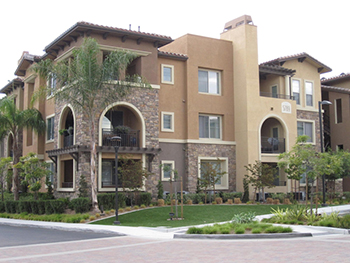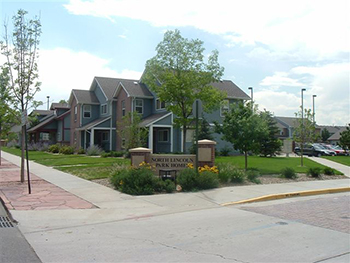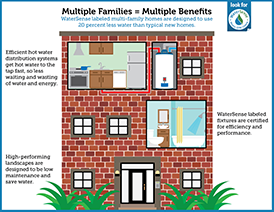The WaterSense Blueprint
The WaterSense Blueprint: Issue IV, Winter 2015
The WaterSense Blueprint is a quarterly update dedicated to news and events related to WaterSense labeled new homes. Sign up to receive The WaterSense Blueprint and get WaterSense news delivered right to your Inbox. You can also help spread the word by distributing Blueprint (6 pg, 677K, About PDF) to builders and developers looking to incorporate water efficiency into their projects. If you missed any of our previous issues, you can find them in our Blueprint Archives.
In This Issue:
- In This Issue
- Technical Corner: Multi–Family Buildings and Single–Family Homes—What Are the Differences for Earning the WaterSense Label?
- NEW! Infographic on the WaterSense Label and Multi–Family Homes
- Builder's Beat: Retrofitting for Deep Water Savings at DHA
- Share the Savings: The WaterSense Label and Multi–Family Homes
- Calendar of Events
In This Issue
Welcome to the fourth issue of the WaterSense Blueprint, which brings you the latest information and updates on the WaterSense New Homes program.
Did you know that the WaterSense label isn't just for single-family new homes? That's right—since 2013, units in many multi–family buildings have also been eligible to earn the WaterSense label. In this issue, our "Technical Corner" focuses on the differences between how single–family and multi–family homes earn the label, as well as the differences in the inspection process. In the "Builder's Beat" section, we talk to Chris Jedd, portfolio energy manager at the Housing Authority of the City and County of Denver (DHA) to find out more about how the organization achieved some serious water savings through retrofits. We also developed an infographic that details the multiple benefits that come from living in a WaterSense labeled multi–family home, as well as some sample social media posts on the topic.
As a reminder, we want the Blueprint to cover the topics you're most interested in, so don't hesitate to let us know what future topics you'd like us to address. Email those and other comments to watersense@epa.gov.
Technical Corner: Multi–Family Buildings and Single–Family Homes—What Are the Differences for Earning the WaterSense Label?
In 2013, WaterSense adjusted the scope of the WaterSense New Home Specification to allow many homes in multi-family buildings to earn the WaterSense label.
To earn the label, units must include WaterSense labeled plumbing fixtures, efficient hot water delivery systems, individual metering/monitoring systems, and other water-saving features inside the unit, as well as for many common spaces, such as laundry rooms and outdoor areas throughout the property. Units that earn the WaterSense label are independently certified to meet these criteria, giving residents confidence that both their homes and the facility as a whole will save water inside and out.
Earning the Label in Multi–Family Buildings

Multi–family building in San Diego, California
(Courtesy H.G. Fenton Company)
Homes in multi-family buildings are eligible for the label if they are in buildings three stories or less (above grade) or if they have individual heating, cooling, and hot water systems separate from other buildings. Homes are also eligible if they are in buildings that use central hot water systems powered by alternative energies (e.g., solar or geothermal) for domestic hot water, where the alternative energy source provides at least 50 percent of the load for residential hot water needs.
So what about mid- or high-rise buildings with central heating, ventilation, and air conditioning and hot water systems? Unfortunately, homes in these buildings aren't eligible for the label at this time. But that doesn't mean they can't be efficient! In fact, when designed, operated, and maintained properly, central systems can be some of the most efficient technologies available. For purposes of WaterSense labeled homes though, they are substantially outside the scope of WaterSense's requirements. If you are constructing or operating a building that is not eligible to earn the WaterSense label, take a look at WaterSense at Work—a compilation of water efficiency best management practices that will help units in your building save water, energy, and money.
Criteria for Common Areas
So what makes inspecting homes in a multi-family building different? There are several types of common areas that have "pre-requisite" criteria, including:
- Common laundry areas
- Landscape and irrigation
- Pools
All equipment in common-use laundry rooms must meet the criteria outlined in the new home specification. Specifically, clothes washers should be ENERGY STAR® qualified with a water factor of less than or equal to 6.0 gallons of water per cycle per cubic foot of capacity, which inspectors verify for every machine installed.
Additionally, the landscape design for all common-use outdoor areas must be designed using the WaterSense Water Budget Tool as outlined in the specification. Residential units in multi-family buildings will only be eligible for the WaterSense label if all common-use outdoor areas meet this criteria. Areas that are reserved for private use of a particular residence (e.g., areas deeded, identified as limited-use common elements, or otherwise restricted by building management) are excluded from the landscapable area.
Finally, common–use pools and spas in multi–family buildings are approached differently in multi-family buildings than in single–family homes. Pools in multi–family buildings must have:
- Independently metered supplies, so that water use attributable to the pool and/or spa can be tracked and leaks can be readily identified.
- Gutter or grate system to catch water splashes or drag-outs.
- Either sorptive media or cartridge filtration.
If specific units are done before all the common areas are completed, the indoor inspection can be completed in those units first, but the label will be held until after final inspection of the common areas.
Checking for Leaks
In many instances, inspecting pressure settings or looking for leaks also requires a different approach. In a single-family home, the inspector often starts with the hose bib. Many units in multi-family buildings don't have hose bibs; in these instances, washer hook-ups make a convenient alternative test location. If no ¾-inch hose bib is available, the inspector can use an adapter (readily available at most plumbing supply stores) to connect a pressure gauge to a sink.
Additionally, some homes might lack individual shut-offs, which is often an indication of riser pipe plumbing where supply lines run vertically throughout the building rather than throughout each individual unit. In this case, a fixture might be more closely connected to a fixture in an adjacent home above and/or below it than to other fixtures within the individual home. If you believe that you're dealing with riser pipe plumbing, contact the WaterSense Helpline for technical assistance.
There are other specific requirements for units in multi-family buildings to earn the WaterSense label. For example, each unit must be individually metered, submetered, or equipped with an alternate technology capable of tracking water use and making that information available to the homeowner. In addition, inspectors must verify that some sort of metering/monitoring technology is present. Builders also need to include both a resident manual and a maintenance manual to ensure proper maintenance of all features over time.
Are you constructing units in multi-family building that could earn the WaterSense label? Learn more about the specification and the inspection and certification process.
NEW! Infographic on the WaterSense Label and Multi–Family Homes
When prospective home buyers or renters purchase or rent a water-efficient unit, they are investing in the future of their community. WaterSense makes it easy to identify homes in multi-family buildings that save both water and energy by labeling multi-family units that are independently certified to use 20 percent less water than typical new homes. Use this infographic on websites and via social media to promote WaterSense labeled multi-family apartments and condos in your buildings.
Builder's Beat: Retrofitting for Deep Water Savings at DHA

DHA manages thousands of affordable single- and multi-family units across the City and County of Denver, Colorado. Over the past decade, DHA has been systematically retrofitting its units to make them more sustainable with a large focus on water efficiency. To learn more about the steps DHA took to make its housing stock more water-efficient, WaterSense talked to Chris Jedd, DHA's portfolio energy manager.
In the mid-2000s, DHA began working toward a more sustainable housing portfolio by making the units more energy- and water-efficient. Working with an energy performance contractor, it began retrofitting fixtures across its entire public housing portfolio (approximately 3,600 homes), replacing traditional residential plumbing fixtures with water-efficient, high-performance options. In 2012, DHA established the energy manager position within the organization to create in-house energy management capacity and minimize the reliance on third-party energy service companies. In addition to the new position, the organization focused on creating a culture of sustainability through branding its efforts around a "Living Green" initiative for DHA staff and residents.
DHA's focus on indoor water conservation includes replacing the following fixtures with high-efficiency, high-performance models:
- Standard bathroom and kitchen faucet aerators
- Standard showerheads
- Older, inefficient toilets
When selecting the replacements for indoor products, DHA made sure to focus not only on water efficiency but also on product performance, functionality, and the overall look of the product. Previous retrofits have demonstrated that when a product doesn't perform well, many residents will find a way to get around the water-saving features—even going as far as replacing the fixture with a different model that won't result in water savings. WaterSense product specifications include both water efficiency and performance criteria, so you can be sure the product performs well while still saving water.
The indoor retrofit was only one piece of DHA's efforts. In order to realize as much water savings as possible, it also focused on outdoor water consumption.

DHA's North Lincoln Park property
As part of its outdoor water conservation plan, DHA identified three areas in which it could realize greater savings:
- Removing the majority of outdoor hose spigots.
- Converting Kentucky bluegrass to a native seed that required less water, is more drought-tolerant, and is native to the climate.
- Retrofitting standard clock timers with weather-based landscape irrigation controllers to water only when needed.
The first step DHA took was to remove all the outdoor hose spigots from its units, which was a big help in decreasing outdoor water use. DHA then opted to replace the existing turfgrass (i.e., Kentucky bluegrass) with native seed that included fine fescue, prairie grass, and wheat grass. After conducting a pilot with the native grass mix, DHA anticipates expanding the program to remove additional areas of turfgrass and replace it with the mixture that was better suited to the dry, higher altitude climate. The final step in the equation was replacing the existing clock timer irrigation controllers with "smart" weather-based models. Weather-based controllers—many of which are WaterSense labeled—act like a thermostat for a sprinkler system. They use local weather and landscape conditions to tailor watering schedules to actual conditions on the site and tell the system when to turn on and off. Instead of irrigating using a controller with a clock and a preset schedule, WaterSense labeled controllers allow watering schedules to better match plants' water needs. With proper installation, programming, and maintenance, homeowners and businesses can use WaterSense labeled controllers instead of standard clock timer controllers on their existing systems.
DHA's success has not occurred overnight. In fact, it took years to complete the retrofits and required significant expenditures. Even so, they have been well worth it, as DHA has seen a tremendous payback. When compared to the baseline year of 2004, DHA reduced water consumption at its properties by 46 percent, or 194,000 kilogallons. The water savings translated to a tremendous cost savings of $1.4 million.
In the future, DHA plans to continue their efforts with additional unit rehabilitations and retrofits as appropriate. In addition, any new developments will have a focus on energy and water conservation (i.e., LEED certified).
When embarking on any multi-family building retrofit—large or small—Jedd's biggest piece of advice is to communicate with residents and staff to fully vet your plans and ensure they are clearly understood and appropriate for that property. Equally important is DHA's maintenance staff who are responsible for maintaining and replacing equipment, as well as communicating with new residents who might be unfamiliar with the "DHA Living Green" energy efforts.
His second piece of advice is to ensure that the products you install are high-performance, as well as high-efficiency. If people don't like the way products work, they will find a way around them or simply replace them, which will reduce your total water and money savings. If possible, Jedd advocates testing the products yourself to make sure that they function and perform as intended.
When specifying products, be sure to look for the WaterSense label so that you can be confident that the products you select perform well while saving water.
Share the Savings: The WaterSense Label and Multi–Family Homes
Combine our new infographic with these sample social media posts to highlight the certified performance and water efficiency of the WaterSense labeled products in your homes.
- Units in multi-family buildings can now earn the @EPAwatersense
 label! Find out how these new homes can save H2O - 1.usa.gov/1yrDceu
label! Find out how these new homes can save H2O - 1.usa.gov/1yrDceu
- Multiple families, multiple benefits! Multi-family #WaterSenseNewHomes
 use 20% less water than typical new homes, saving $$$ & energy too.
use 20% less water than typical new homes, saving $$$ & energy too. - @EPAwatersense
 labeled multi-family #WaterSenseNewHomes
labeled multi-family #WaterSenseNewHomes give residents confidence that their home will really save water—inside and out!
give residents confidence that their home will really save water—inside and out! - It's the whole package! Multi-family #WaterSenseNewHomes
 have WS labeled fixtures, efficient hot water delivery, & water–smart landscapes!
have WS labeled fixtures, efficient hot water delivery, & water–smart landscapes!
Wondering how it's possible to save water in your home while living in a multi-family building? Have no fear! Units in multi–family buildings can now earn the U.S. Environmental Protection Agency's (EPA's) WaterSense label, making it easy to identify homes that save both water and energy. Whether you're building your career in a bustling metropolitan area or empty nesters downsizing in your favorite locale, living in a multi–family building is often a wise choice that can reduce upfront costs and your environmental footprint. Units that earn the WaterSense label are independently certified to meet EPA's criteria for WaterSense labeled plumbing fixtures, efficient hot water delivery systems, individual metering systems, and other water-saving features inside the unit, along with outdoor criteria for common spaces on the property. A WaterSense labeled multi-family new home can help you rest assured, giving you the confidence that your home will really save water—inside and out!
Learn more at www.epa.gov/watersense/new_homes/ and contact us at [insert your company/contact information] to get performance and savings you can see and feel.
Calendar of Events
It's Almost Annual Reporting Season!
Help WaterSense measure its performance by submitting information about your 2014 accomplishments. Starting January 8, 2015, annual reporting will be open for business. WaterSense annual reporting gives you a chance to celebrate your accomplishments, while providing WaterSense with valuable feedback to help improve the program. All partners who submit an annual reporting form are eligible to apply for a Partner of the Year award, which recognizes partners who go above and beyond to support WaterSense. Keep an eye out for the annual reporting kick-off email set for Thursday, January 8, 2015. Please submit annual reporting forms by Friday, February 13, 2015, then tell us about your 2014 accomplishments in a Partner of the Year application. Award applications will be available in late January and due in early April.
January 8, 2015: Annual Reporting Kicks Off
January 23, 2015: Q4 2014 WaterSense Quarterly Reporting Deadline
Make sure your licensed certification providers report to WaterSense on any of your homes that earned the WaterSense label during the fourth quarter of 2014. The Q4 2014 reporting deadline is Friday, January 23, 2015.
February 16-18, 2015: RESNET Building Performance Conference
Scheduled for February 16 to 18, 2015 in San Diego, California, the 2015 RESNET Building Performance Conference![]() is a national forum on home energy ratings, residential energy efficiency financing, and building performance business development. In addition to presenting at several educational sessions, WaterSense will be exhibiting at booth #211, so stop by and say hello!
is a national forum on home energy ratings, residential energy efficiency financing, and building performance business development. In addition to presenting at several educational sessions, WaterSense will be exhibiting at booth #211, so stop by and say hello!
March 10-12: 2015 NFMT Conference and Expo
The National Facilities Management and Technology (NFMT) Conference and Expo![]() is set to take place from March 10 to 12, 2015, at the Baltimore Convention Center in Baltimore, Maryland.
is set to take place from March 10 to 12, 2015, at the Baltimore Convention Center in Baltimore, Maryland.





